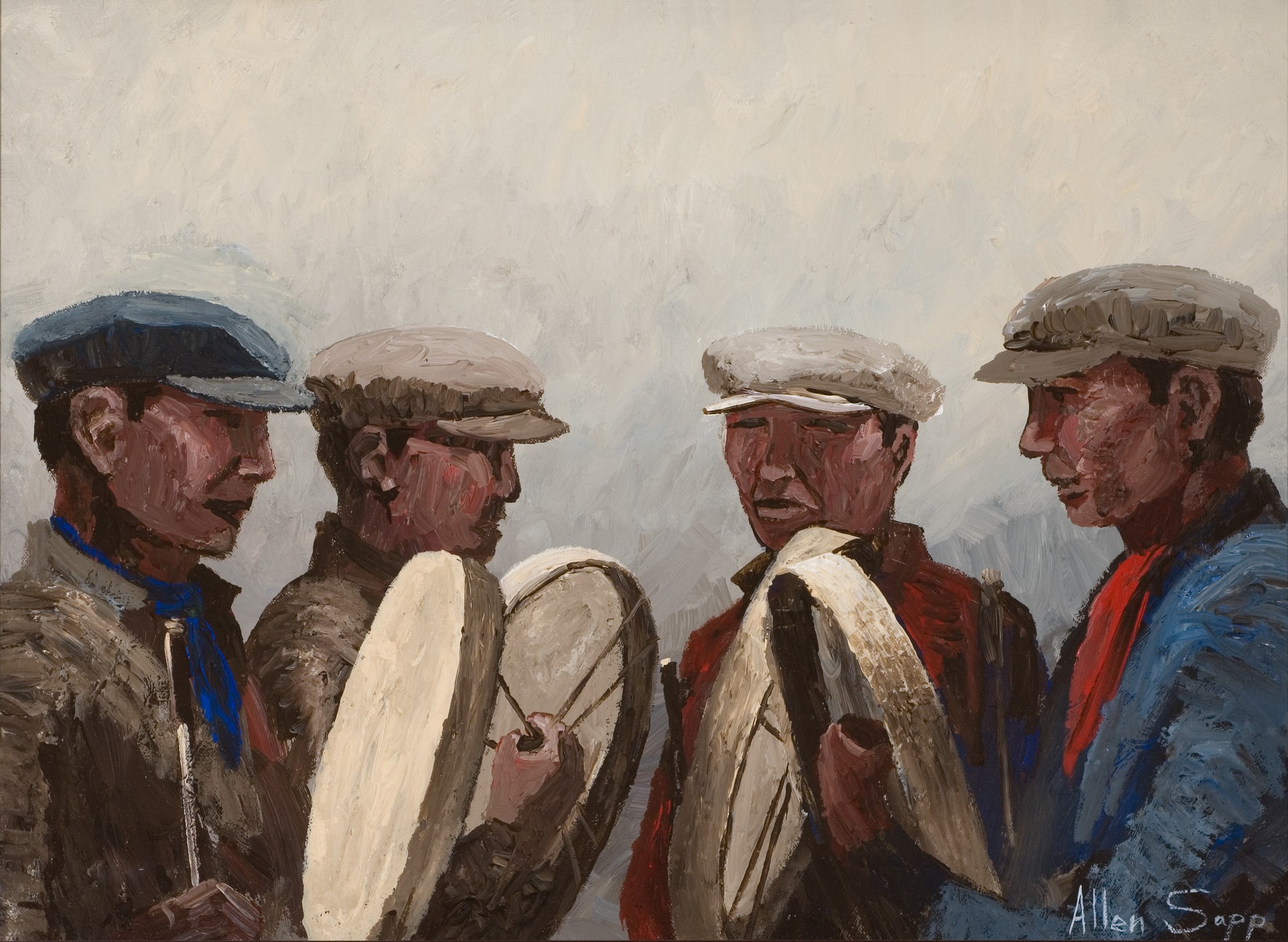Indian Drums
“I was a very young boy when I first heard the drums.” So writes Allen Sapp (1928–2015), the distinguished Cree painter from Red Pheasant Cree Nation in Saskatchewan, in his appropriately titled memoir I Heard the Drums. As he goes on to explain, the sound of the drum lulled him to sleep as a child, caused his heart to race at his first powwow, accompanied him on his lifelong path as a traditional powwow dancer, and continually refreshed his spirit, leaving him, as he says, “ready to paint.” Just as the drum is an essential part of Plains Cree tradition and ceremony, so the image of the drum is a central, animating motif in Sapp’s paintings.
In Indian Drums, a small early painting from 1972, Sapp depicts four drummers standing in a circle. Rather than the large drum used for powwows, the men are playing hand drums of the type used for the Round Dance, an event held both indoors and outdoors. Their drumsticks are suspended, mid-stroke, the reverberations of the last beat still hanging in the air. Although we can’t see it—the background is undefined—a circle of dancers is moving somewhere to the sounds of their drumming and singing. According to curator Dean Bauche, Sapp would often point to objects or people outside the frame when describing the contents of a painting. This is an indication, I believe, of how his relational Cree frame-of-reference exceeds the exclusionary conventions of the frame.
When I first encountered Sapp’s work as a young curator working at the MacKenzie Art Gallery in the early 1990s, I did not understand the importance of his “celebration of the continuity of Cree life,” as scholar Alfred Young Man calls it. Thankfully, the 1994 retrospective curated by Bob Boyer opened my eyes. The exhibition demonstrated that far from being a nostalgic look backwards at reserve life, the artist’s work is a vision of ongoing community that is “strong, vital, happy and alive”, as described by Boyer.
While his solidly realized images are often praised as being “photographic,” what is less often discussed is the quality of his paint application. When I look at his canvases closely, I am often left with the impression that what I am seeing has less to do with the legacies of European art, and more to do with the moose and deer hides that Sapp’s grandmother used to stretch and tan. I would suggest, in fact, that an early painting of his grandmother stretching a moose hide can be read as a mise en abyme of the activity of painting. There is a textural as well as optical realism to his paintings that perhaps only Courbet comes close to, and yet even this comparison falls short.
Consider the background again. The luminous gradation from glowing tans to muted greys echoes the shading on the rims of the drums. Indeed, the background looks and feels like the skin of a drum. And why shouldn’t it? Both drums and paintings are membranes stretched on wooden frames. For Sapp, canvas is a drum that pulses with memories; when we look at his paintings, we join the living circle of the drum.
Timothy Long is the Head Curator at the Mackenzie Art Gallery in Regina, Saskatchewan.

Object details
Artist
Allen Sapp
Cree culture
Red Pheasant Reserve, Saskatchewan, 1928
North Battleford, Saskatchewan, 2015
Title
Indian Drums
Date
1972
Medium
Acrylic on canvas
Dimensions
H: 58 cm
W: 74 cm
Credit
Part of the National Capital Commission’s Official Residences Crown Collection
Image copyright
© Estate of Allen Sapp




